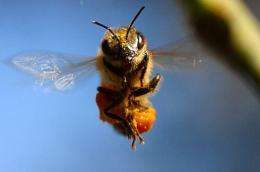Credit: pdphoto.org
The population of honeybees remains endangered, threatening the world's food supply, and scientists have decided that the best way to save the insects may be to breed a better bee.
Researchers are breeding bees with the special ability to resist the mites and viruses that, according to the United Nations, have killed 10-30 percent of the bees in Europe each year, almost a third of American bees, and as much as 85 percent of the bees in the Middle East. The breeding efforts are slowly starting to succeed.
Researchers at the University of Manitoba in Winnipeg are shipping queen bees from hives that show some resistance to the mites across Canada. The scientists, along with colleagues at the University of Guelph in Ontario, then expose the queens to high levels of "disease pressure" according to Rob Currie, professor of entomology at Manitoba. The survivors then are bred the next season and so on -- seven generations so far.
Beekeepers usually breed bees by taking a queen from a hive, but these new efforts are designed specifically for the current situation. Breeding programs also exist at the University of Minnesota and at the Department of Agriculture's research labs in Baton Rouge, La., according to Dave Mendes of the American Beekeepers Federation.
Meanwhile, the threat to the food supply remains. Besides producing honey, bees are one of the main conduits for pollination. Worldwide, food valued at $83 billion -- $15 billion in the U.S. alone -- is at risk since more than 100 different crops depend on bee pollination.
Mites -- tiny arachnid-like ticks -- and the viruses they carry are believed to be the primary culprits behind the rapid drop in bee populations known as colony collapse disorder. In addition, a fungal infection can also destroy hives.
According to the Department of Agriculture, 33.8 percent of American honeybee colonies were destroyed between October 2009 and April 2010, a 5 percent increase from the previous year.
The destruction is not uniform. In some areas, whole hives have been decimated, while in others, beekeepers report that colonies are doing well. No one knows what causes the disparity, according to Eric Mussen, extension agriculturist at UC-Davis in California.
People have been keeping bees for honey and pollination since time out of mind, but this bee plague first appeared in 1920 when mites, tiny arachnids, infested and killed off bees on the Isle of Wight off the coast of Britain. The United States passed a law forbidding the commercial importation of foreign bees to protect the domestic industry, but no one could stop the importation of mites.
In 1987, a new kind of mite first appeared in Florida and then Wisconsin and the destruction of North America hives began.
"By 1995, you could barely find a feral colony," Mussen said.
Industrial-sized bee farms were hit as were backyard hives. As some bees developed resistance, the same thing happened to the mites: spraying produced mites resistant to the insecticides. Researchers think that breeding resistant bees would be a lot easier than trying to eradicate the mites.
"We are looking for bees that are resistant to mites and with a greater tolerance to viruses because they appear to be the two main factors behind colony loss," Currie said.
An added attribute is the ability to withstand the brutal North American winters.
Currie said that normally only 46 percent of the species known as European honeybees survive the winter, but the newest generations have a 75 percent survival rate.
In order to do the experiments, the Canadian researchers even grow their own mites, "a form of anti-beekeeping," Currie said.
Mussen said some species of bees are capable of destroying the mites before the mites get them, particularly Russian bees, brought in by the USDA and now being bred in Louisiana. Mussen calls them "hygienic," capable of cleaning themselves of the mites, sometimes in organized hive-wide mite patrols.
"Bees are very complex creatures," Mussen said.
Provided by Inside Science News Service






















